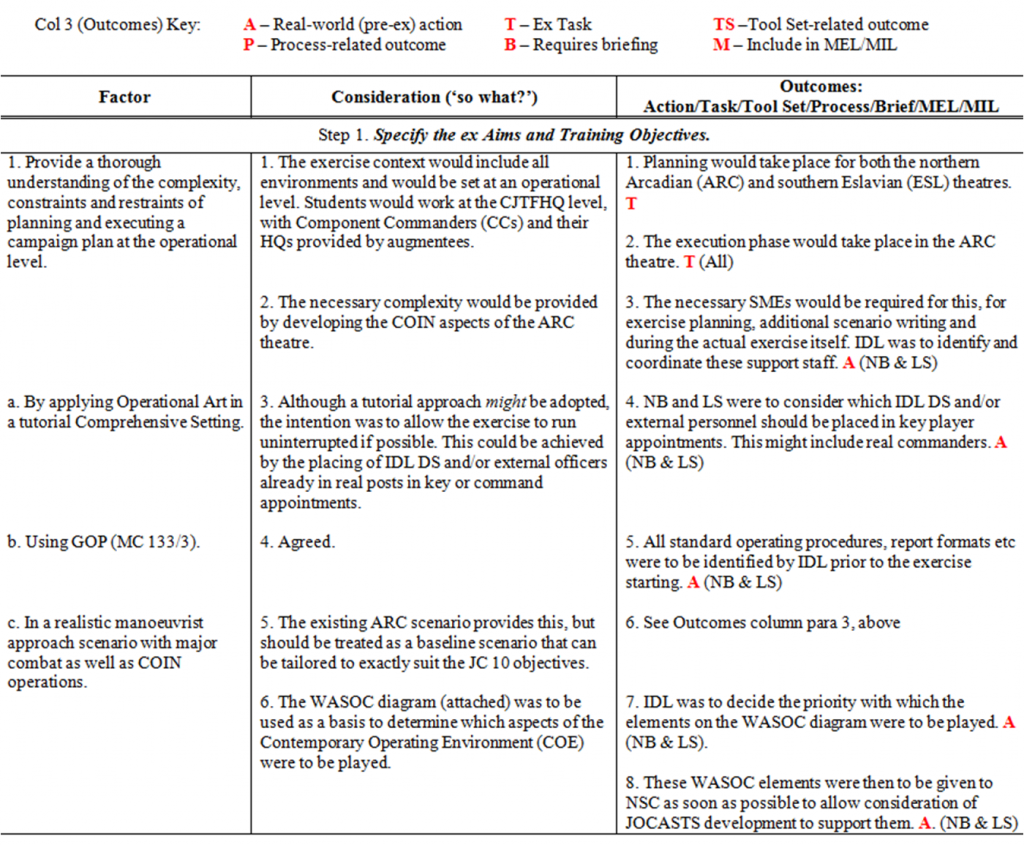Case Studies
The Netherlands Staff College Theatre Wargame ← Back to Case Studies index
Working for and at IDL is always a pleasure. The Directing Staff (DISTAFF) are always determined to deliver the most effective educational wargame possible, but they are also prepared to listen to and act on advice. In contrast to many other institutions with a high staff turnover, continuity is maintained and lessons learned carried forward. Hence the full wargame cycle described on the How we do it page (design – develop – execute – validate – refine) is enacted. The result is a first class educational CAX with all elements of the wargame combining to deliver well defined Training Objectives (TOs).
A full wargame design workshop was run for the first iteration of JOINT CHALLENGE in its current form. This lasted a day and was based around the ‘design’ steps outlined on the How we do it page and detailed in the ‘Avoiding Common Errors in CAX’ article on the Resources page. The start point was, of course, the anticipated TOs.
Each step was worked through using a three-column format mechanism adapted from that used by the UK Armed Forces for conducting estimates. The columns are: Fact (or) – Consideration (‘so what’) – Output (Decision or Action). The outcomes of the third column will be one of:
- Real-world (pre-exercise) action
- Exercise task
- Requires briefing
- Include in Master Events/Injects Lists
- Tool-set related action
- Process related action
Is this obvious? Yes. It is also just a variation on an existing problem solving mechanism. But such workshops are seldom held. It is amazing how often Step 1 results in a frenzied scrabble to try and find the TOs, which either don’t exist or have not been re-visited in the recent past.
An extract from the full document produced for IDL as a Record of a Meeting (the audit trail required in Step 7 of the design process) is shown below by way of example.
This logical and thorough design process – involving the military, operational analysts, software engineers and a wargame designer – ensures a sound basis from which all elements of the wargame are derived. These are then developed in a distributed but collaborative manner. Examples are the development of the scenario, including MEL/MIL serials and any software changes to enable features of the COE to be modelled, or at least represented on the JOP. The outcomes of the design process directly feed in to, and are briefed at, the Initial Planning Conference. All key stakeholders attend. Briefing the design outcomes allows these to be discussed, confirmed or refined, and so ensures stakeholder buy-in. Work then continues in a distributed fashion.
Final confirmation of the developing exercise occurs during the 3-day Main Planning Conference (MPC), and is the Test Exercise (Testex). The Testex is a key activity. It is a full test of 24 hours worth of Excon battle rhythm, involving as many of the final Excon staff as possible. These personnel attend the MPC or are IDL DISTAFF. The aim of the Testex is to try to break all Excon and exercise processes; to stress the game mechanics, including the simulation, to identify areas of weaknesses. Any that are found are remedied immediately or, in the case of software issues, subsequently.
Because the Testex runs concurrently with the MPC, outcomes can be briefed back in central plenary. Testing 24 hours of Excon battle rhythm does not mean personnel staffing Excon for 24 hours! Meetings are held at the times they would be during the actual exercise, processes are discussed and adjustments made. The simulation used to support the exercise (the Joint Operational Command and Staff Training System – JOCASTS) runs throughout so simulation outcomes are fed into the Testex. This allows both the simulation and Excon processes to be tested. It is usually difficult to define in advance what problems will be identified during the Testex. What is certain, however, is that it is always considered an essential activity once it has taken place!
Exercise development is finalised at, and immediately after, the MPC. Activity at the Final Planning Conference concentrates on administrative matters. The only elements of the exercise that continue to be refined are MEL/MIL serials and any Blue Hicon documents such as Initiating Directives. These are produced immediately prior to Startex by small writing teams that come together a day or so before the students start reading in.
← Back to Case Studies indexComments are closed.


